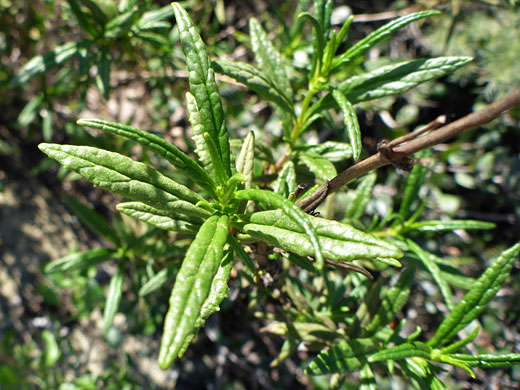Common name:
Red bush monkeyflower
Family:
Scientific name:
Diplacus puniceus
Main flower color:
Range:
Southern California, along and near the coast
Height:
Up to 5 feet
Habitat:
Chaparral, washes, canyons, rocky slopes; up to 2,000 feet
Leaves:
Narrowly oblanceolate to lanceolate or linear, up to 2.3 inches long, usually with finely toothed margins
Season:
January to July
Diplacus puniceus grows in coastal regions of southern California, between San Diego and Santa Barbara, plus a few scattered sites around San Francisco Bay. Plants are sprawling shrubs, typically 3 or 4 feet tall, with hairless stems and leaves. The stalkless leaves are narrow, generally linear or nearly so in shape, with a prominent, depressed midvein. Margins are are usually faintly toothed, and somewhat rolled-under.
The plant is in bloom throughout the first half of the year, and sometimes into the fall. There are usually two flowers per leaf node. Calyces are up to one inch long, pale green, strongly five-ribbed (the ribs darker green), and unequally five-lobed. Corollas are longer, up to 1.5 inches, funnel-shaped, opening to two lips, the upper two-lobed, the lower three-lobed. Corollas are orange-red, less often paler orange, or yellow. The stigma and two of the four stamens are exserted.
The plant is in bloom throughout the first half of the year, and sometimes into the fall. There are usually two flowers per leaf node. Calyces are up to one inch long, pale green, strongly five-ribbed (the ribs darker green), and unequally five-lobed. Corollas are longer, up to 1.5 inches, funnel-shaped, opening to two lips, the upper two-lobed, the lower three-lobed. Corollas are orange-red, less often paler orange, or yellow. The stigma and two of the four stamens are exserted.
All Contents © Copyright The American Southwest | Comments and Questions | Contribute | Site Map


